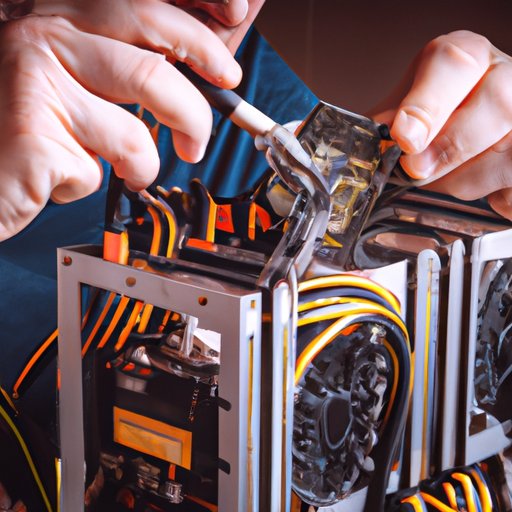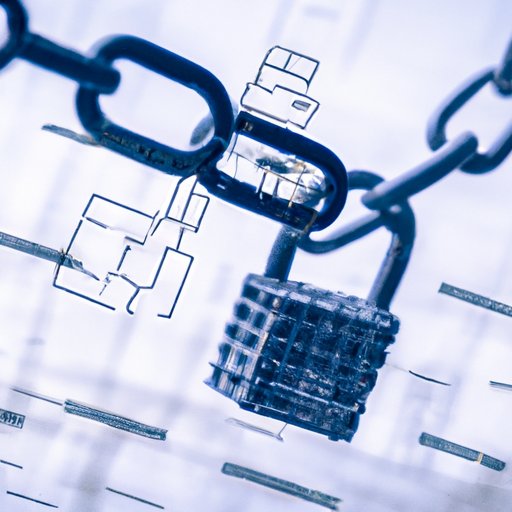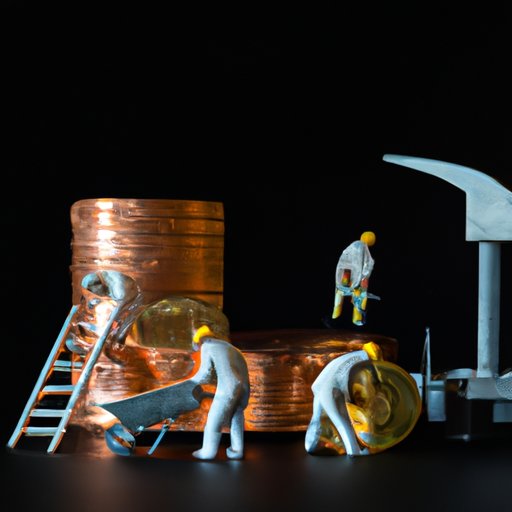Introduction
Bitcoin is a digital currency that has been gaining popularity over the past few years. It is a decentralized currency, meaning it is not controlled by any government or financial institution. Instead, it is created and maintained by a network of computers around the world. This network is known as the “Bitcoin network” or the “Bitcoin blockchain.”
The purpose of this article is to explore the technology and economics behind Bitcoin mining. We will examine the technical details of how Bitcoin is created and secured, the role of miners in the network, and the costs and strategies involved in maximizing profits from Bitcoin mining.

Exploring the Technical Details Behind Bitcoin Mining
Before we can discuss the economics of Bitcoin mining, it is important to understand the technical details of how Bitcoin is created and secured. In order to do this, we will explore the concepts of Bitcoin mining, the blockchain, blocks, hashes, and miners.
What is Bitcoin Mining?
Bitcoin mining is the process of verifying and adding transaction records to the public ledger of past transactions, known as the blockchain. This is done using specialized hardware and software designed to solve complex mathematical problems. When a miner successfully solves a problem, they are rewarded with a certain amount of newly created bitcoins.
How Does Bitcoin Mining Work?
When a user sends a transaction, it is broadcast to all nodes (computers) on the network. These nodes then verify the transaction and add it to their copy of the blockchain. In order for a transaction to be added to the blockchain, a miner must find a solution to a difficult mathematical problem. The miner who finds the solution is rewarded with newly created bitcoins.
What is the Blockchain?
The blockchain is a distributed database that stores all past transactions. It is constantly growing as new blocks are added to it. Each block contains a cryptographic hash of the previous block, a timestamp, and transaction data. This data is stored in a Merkle tree structure, which allows for efficient and secure storage of large amounts of data.

Examining the Blockchain Technology Used to Secure Bitcoin Transactions
In order to ensure that all transactions are securely recorded, the Bitcoin network uses several different technologies. We will now take a closer look at blocks, hashes, and how these technologies are used to secure transactions.
What is a Block?
A block is a collection of transactions that have been verified and added to the blockchain. Each block contains a cryptographic hash of the previous block, a timestamp, and transaction data. This data is stored in a Merkle tree structure, which allows for efficient and secure storage of large amounts of data.
What is a Hash?
A hash is a unique string of letters and numbers that is used to identify a specific block. Every block in the blockchain has its own unique hash. A hash is created by running a cryptographic algorithm on the data contained in a block. This ensures that each block is securely linked to the previous one.
How Does the Blockchain Secure Transactions?
The blockchain is designed to be immutable, meaning that once a transaction has been added to the blockchain, it cannot be changed. This is achieved by using cryptographic hashes to link each block to the previous one. If someone were to try and alter a transaction, the hash of the block would change, making it easily detectable.

The Role of Miners in Securing the Bitcoin Network
Miners play an important role in securing the Bitcoin network. Without miners, it would be impossible to verify and add transactions to the blockchain. We will now take a closer look at what miners do and why they participate in the network.
What is a Miner?
A miner is an individual or group of individuals who use specialized hardware and software to solve complex mathematical problems. Once a miner has found a solution to a problem, they are rewarded with newly created bitcoins.
Why Do Miners Participate in the Bitcoin Network?
Miners participate in the Bitcoin network because they are rewarded with newly created bitcoins for verifying and adding transactions to the blockchain. This gives them an incentive to continue to secure the network and verify transactions.
What Rewards do Miners Receive?
When a miner successfully solves a problem, they are rewarded with newly created bitcoins. This reward is halved approximately every four years. Currently, the reward for solving a problem is 12.5 bitcoins.
Analyzing the Economics of Bitcoin Mining
Now that we have explored the technical details of Bitcoin mining, let’s take a look at the economics of it. We will examine the costs involved in Bitcoin mining, what factors affect profitability, and what strategies can be used to maximize profits.
What are the Costs Involved in Bitcoin Mining?
The costs involved in Bitcoin mining include the cost of the hardware and software used to mine, the cost of electricity, and the cost of cooling the hardware. In addition, miners must pay a fee for each transaction they add to the blockchain.
What Factors Affect the Profitability of Bitcoin Mining?
The profitability of Bitcoin mining depends on several factors, including the cost of hardware and electricity, the price of Bitcoin, and the difficulty of mining. As the price of Bitcoin increases, so does the profitability of mining; however, as the difficulty of mining increases, the profitability decreases.
What Strategies Can be Used to Maximize Profits?
In order to maximize profits from Bitcoin mining, miners should use the most efficient hardware and software available, minimize their electricity costs, and keep up to date on the current market conditions. Additionally, miners should diversify their investments and use strategies such as hedging to protect against price fluctuations.
Understanding How Bitcoins are Stored and Transferred
In addition to understanding the technology and economics behind Bitcoin mining, it is also important to understand how bitcoins are stored and transferred. We will now take a look at how bitcoins are stored, how they are transferred, and what security measures are in place to protect Bitcoin transactions.
How are Bitcoins Stored?
Bitcoins are stored in digital wallets, which are protected by a private key. This private key must be kept safe and secure, as anyone who has access to it will be able to spend the bitcoins stored in the wallet.
How are Bitcoins Transferred?
Bitcoins are transferred between wallets using the Bitcoin network. When a user sends a transaction, it is broadcast to all nodes on the network. These nodes then verify the transaction and add it to their copy of the blockchain. Once the transaction is added to the blockchain, it is considered to be complete.
What Security Measures are in Place to Protect Bitcoin Transactions?
The Bitcoin network uses several different security measures to protect transactions. These include encryption, digital signatures, and proof-of-work algorithms. Additionally, all transactions are stored on the blockchain, which is immutable and secure.
Conclusion
This article has explored the technology and economics behind Bitcoin mining. We have examined the blockchain technology used to secure transactions, the role of miners in the network, and the costs and strategies involved in maximizing profits from Bitcoin mining. We have also looked at how bitcoins are stored and transferred, and what security measures are in place to protect Bitcoin transactions. From this exploration, it is evident that Bitcoin mining is a complex process, but one that can be profitable if done correctly.
(Note: Is this article not meeting your expectations? Do you have knowledge or insights to share? Unlock new opportunities and expand your reach by joining our authors team. Click Registration to join us and share your expertise with our readers.)
